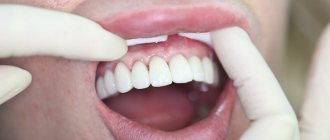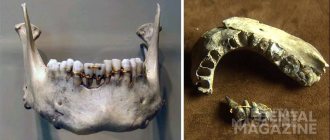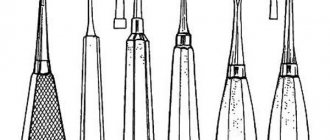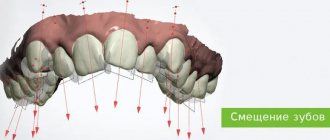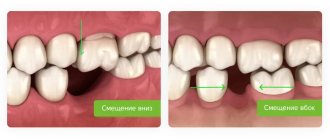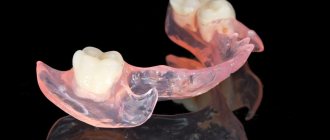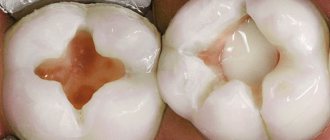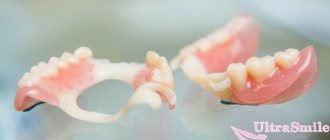Pros of ceramics
Engineers and chemists of large concerns for the production of dental materials (mostly German) are very hardworking and purposeful people. This is not a common stamp - I was convinced of this from my own experience, watching the evolution of ceramic crowns from Ivoclar Vivadent for 15 years. This is not an advertisement - this name means little to the average person, and dentists do not trust advertising. Over the years, the company has come a long way from really fragile crowns in the 2000s (the instructions said so - only for front teeth, with a bunch of contraindications) to the modern material e.Max (Imax, emphasis on the letter I), which in most cases regions is crowding out the former grandee - zirconium dioxide.
Let's list what makes Emax so remarkable:
- Strength. Allows you to make not only crowns, but also bridges. Not only for front teeth, but for any teeth. There is enough strength to spare.
- A huge selection of colors, transparency options , the possibility of individualization either by simple painting or by applying additional layers of ceramics (this is the finest work on the verge of craft and art, in some cases up to 15 layers of ceramics are used, achieving incredible naturalness).
- Possibility of manufacturing individual implant abutments. The abutment is the outer part of the implant; the crown rests on it. There are two options for their use - standard titanium abutments manufactured at the factory (there is no time for aesthetics here, the strength or complexity of the design is important) or individual abutments. If you make such an abutment from Imax material, the crown on the implant (by the way, it can also be Imax) will be more aesthetically pleasing.
- Emax has brought digital technology directly to the dental chair. Now the doctor can make crowns on his own and in one visit . The aesthetics and strength are the same, the accuracy is higher - the human factor is reduced to a minimum. This technology is called CEREC (Cerek, emphasis on the first syllable), in conjunction with modern ceramic materials, it is incredibly convenient for both the doctor and the patient.
- The crown is bonded to the tooth (dentists call this bonding) by creating a chemical bond between the ceramic, adhesive luting cement and the tooth tissue. This connection is absolutely sealed and durable.
How to extend the life of crowns?
Warranty period and service life are not the same thing. A warranty is needed to ensure that the work was done correctly. During this period, the clinic undertakes to replace the structure free of charge in case of breakdown.
But a high-quality crown will last longer than the 2-5 year warranty period. Optimal: 10 years or more. It's like with a computer: it has a 1-year warranty, but you use it for much more. And all because you treat him correctly. In this case we are talking about service life.
What can a patient do to make the crown last a long time?
Before installation
Materials. When choosing a clinic for dental prosthetics, pay attention to the materials of the crowns. You can see them in the price list, in the estimate after a consultation, or check by phone. Dental ceramics brands are usually not well-known, but you can read about them on the Internet. Brands that are not mentioned anywhere or the clinic’s refusal to name the manufacturer should raise red flags.
Doctor. When choosing a doctor, patients often look at examples of work. But from the photographs you can see the skills of a specialist in aesthetic dentistry. But for a long service life of the crown, it’s better to look at what topics the doctor has improved his qualifications on. The words “occlusion” or “load” in the titles of courses and seminars are a good sign.
View. The average service life of metal-ceramic, zirconium and ceramic crowns depends more on care than on type. Modern cements allow the crown to last almost a lifetime, as long as the health of the tooth and careful handling allow it. However, when planning treatment, be sure to listen to your doctor's opinion. The most expensive and considered reliable option is not always suitable for a particular patient.
Immediately after installation
Make sure that the teeth fit together comfortably with the crown and that nothing is in the way. It is often difficult to understand at an appointment whether the new design is comfortable. The patient sat for an hour with his mouth open, and his jaw was numb from immobility. What to do? Take a break until tomorrow. After resting, starting to talk and chew, you will feel if something is wrong.
Don't hesitate and don't delay. Getting used to the crown takes a couple of hours, and if the next day you are still uncomfortable, make an appointment with your orthopedist. The doctor will see you as soon as possible.
Lifetime
10 or more years. The main thing is to properly care for the restoration.
We take care of the crown
The material of modern crowns is not inferior in strength to natural enamel. But the list of harmful, traumatic factors remains.
Do not crack nuts with your teeth, bite threads, open bottles, or untie knots. It is not recommended to hold nails, screws, etc. in your mouth like a carpenter. If you play dangerous sports such as hockey or boxing, be sure to wear a mouthguard.
Remember: anything that can chip a tooth can chip a restoration.
Protecting the tooth under the crown
The crown protects against tooth decay, but a small part of the tissue under the gum remains vulnerable to bacteria. Carefully observe oral hygiene: regularly and properly brush your teeth, use floss or a special brush, as well as an irrigator. Don't let an infection form under your gum.
Well-groomed gums are protected from periodontal disease, so teeth are stable and firmly held in place.
Let's take care of our neighbors
It is important that the remaining teeth are also in order. If the neighboring one is destroyed, it needs to be built up or strengthened with a crown, otherwise it will no longer participate in chewing. The load will be distributed unevenly. Then other teeth, including the one with an expensive crown, may chip or shift.
If an adjacent tooth is lost, it should be restored with an implant or bridge. If this is not done, the teeth on the sides will begin to shift towards the failure. And the opposing tooth on the other jaw will become mobile in the absence of load.
The situation will become even more complicated if several units are lost. The risk of crown breakage or chipping of veneering ceramics will increase many times over.
We protect the entire dental system
It's not just about healthy eating and preventative procedures. It is important to contact your dentist in a timely manner if any problems arise in the oral cavity, even those not related to a specific crown.
For example, bruxism often causes a short lifespan for crowns. If your orthopedic structures break down after 3-4 years, be sure to tell your doctor about it. Bruxism, spasmodic clenching of the masticatory muscles, can be successfully treated both before and after prosthetics.
Orthopedic dentist V.A. Chesnokov: I recommend coming in for an examination once a year, even after the warranty period has expired. The orthopedist will check the load distribution using a carbon paper. The fact is that over the years, teeth naturally wear down and decrease in height. But the crown is harder than enamel, it does not wear off. And over time, it becomes the highest point on the jaw; it bears the entire load when chewing. This could cause the crown to break. Trouble can be easily avoided by simple checking and polishing.
Signs that replacement is needed
There are a number of signs that allow you to determine that it is time to change the crown. These factors include:
- color change;
- development of pathological processes;
- breakage of the prosthesis;
- formation of plaque accumulation areas;
- bleeding gums, which is a sign of the development of inflammatory processes;
- tight interdental contact.
In addition, complaints about symptoms such as increased pain, bad breath, discomfort and food getting stuck near the crown may be the reason for replacing the denture.
The problem with old crowns that are 10 – 20 years old or more
Many people have old orthopedic structures in their mouths: bridges, crowns.
They can be metal or combined plastic. Patients come to us who have been wearing these crowns for 20 years or more. And then there comes a time when a person is no longer satisfied with the old crowns.
- Old crowns are not functionally satisfactory, since they can no longer chew food normally, because they have already eaten, sometimes even worn down to holes.
- Old crowns are not aesthetically pleasing
, as they are worn out, blackened, grayed, and chipped.
How to quickly restore beauty to your teeth
Metal-ceramics, from which crowns are installed on the front teeth, are made in the traditional way with an impression. And prostheses made of ceramic or zirconium can be obtained in just 1.5 hours using Cerek technology. One anesthesia will be required, or you can do without it. The prosthesis is installed on a fresh, just prepared surface.
The technology is relevant for the production of metal-free crowns:
- The problem area is scanned and the model is reproduced by a computer.
- The anatomical dimensions and shape will exactly repeat the “native” tooth.
- The program will create a model and send the job to the grinding unit, where the design will be created.
If the shade is slightly different from the desired one, a new ideal copy can be easily created. A single crown is installed or an option is created for two front teeth.
What are dental crowns?
The destruction of teeth in the oral cavity makes it impossible to perform their main function - grinding and chewing food. To restore the functional purpose of a partially or completely deformed tooth, a prosthetic procedure is used. It involves the installation of crowns, which are caps fixed to the supporting part.
The root of a damaged tooth can serve as a support, but only if it is fully suitable. If not only the upper part is deformed, but also the root has significant damage, then an implant is used.
The crown is made in a dental laboratory based on previously taken impressions. After this, it is attached to the root and becomes a full-fledged tooth replacement. With the help of crowns, chewing and speech functions are restored, in addition, a person gets the opportunity to smile freely.
Indications and contraindications
Installation of crowns for bite correction is advisable if the patient has certain pathologies:
- Reduced or enlarged elements.
- The presence of defects on the surface of the teeth (chips, damage).
- Curvature or rotation of clinical crowns.
- Increased interdental spaces.
- The top of the unit is completely or partially destroyed.
- Implantation of an implant instead of a removed element.
- Unit divergence.
Covering with crowns does not correct every malocclusion. To eliminate some defects, it is necessary to use other methods that do not require grinding of the support unit.
Prosthetics cannot correct pronounced defects in which the shape and position of the clinical crown and root are disrupted. In such situations, alternative correction methods are used.
It is prohibited to use crowns if the wall thickness of the element is insufficient due to the risk of thermal burn of the pulp.
What will result from untimely replacement?
People are reluctant to visit dental offices, but if you experience discomfort from a crown, you should immediately contact a specialist. Untimely replacement of the prosthesis threatens the following negative consequences:
- Root destruction - a cap not only allows you to restore the function of a damaged tooth, but also protects its root from further deformation. Over time, the supporting part is negatively affected. The bond is gradually destroyed by the action of saliva, which ultimately contributes to the accumulation of food debris and microbes. It is impossible to remove them with a toothbrush, so the process takes a long time and is asymptomatic. As a result, the root is destroyed, which may subsequently lead to the need to remove it.
- Development of inflammatory processes - inflammatory processes can develop in the gums, which not only cause discomfort, but also lead to more serious consequences. If the prosthesis (especially a low-quality one) is not replaced in a timely manner, you can lose all adjacent teeth.
A dentist, whose visits should be regular, will help you make sure that you need to replace the crown. It is important to understand that it is almost impossible to determine this on your own and, as a rule, patients turn to a specialist already too late.
Prosthesis replacement technology
If the need to replace the prosthesis is identified, then the procedure involves performing the following actions:
- Removal of the old crown and production of a temporary prosthesis. It is made using a silicone key.
- Assessment of tooth condition. If the root is in order, then it must be cleaned, processed to give it the correct shape, and also remove possible caries.
- Impressions are taken to make a new crown and sent to a dental laboratory. The duration of production depends on various factors, but in any case, the patient does not walk without a prosthesis. On the same day, a temporary cap is installed.
Upon completion of the crown, the doctor informs the patient about this. At the appointed time, the new prosthesis is installed. All types of products (even the most expensive ones) have a certain resource, so it is important to understand that sooner or later there will be a need to replace them. It is especially important for people with crowns to monitor the condition of the oral cavity and regularly visit the dentist for preventive examinations.
How long will different types of crowns last, and what determines their “life”?
To have an idea of how often crowns need to be replaced, you should learn about the service life of various orthopedic structures. So let's look at this aspect from the perspective of different ways of classification.
For example, according to the period of wearing, temporary and permanent ones are distinguished. Temporary ones (made of composite or acrylic) last a very short time - from several days to 3-12 months. Permanent ones can last an average of 5-7 years. After how many years crowns are replaced depends on their service life, materials, manufacturing features, and how properly a person cares for them.
If we consider materials, then ceramic and metal-ceramic products will last up to 10 years maximum - with very good care. Zirconium dioxide or those made from lithium disilicate last longer - from 15 years. The manufacturing method is also important here - for example, zirconium dioxide structures milled with special devices can last more than 25 years. And ceramics processed using the classical method (manually) lasts about 7 years.
Indications for use
The main reasons for the absence, for the elimination of which the dentist will suggest installing a crown on the tooth, include:
- destruction by 50% (both as a consequence of advanced caries and mechanical impact);
- the aesthetic side associated with the occurrence of chips, cracks, deterioration of color compared to the rest of the “brothers” in the series;
- damage to the coronal part (in other words, destruction of the installed prosthesis);
- critical abrasion - bruxism is a pathological disorder in which intervention will serve as protection for tissues.
Important! Bruxism is an involuntary grinding of teeth that occurs in people during nighttime sleep. First, the doctor will recommend undergoing a full diagnosis and treating the cause of the deviation, taking a course using a night guard, before direct placement.
Ceramic veneering
Veneers are usually placed when the front teeth are slightly crooked. Dental veneers are installed very quickly, without the need for invasive procedures, and patients who decide to correct crooked teeth with veneers do not experience pain or discomfort. If you are looking for an option to correct crooked teeth for an adult patient, it makes sense to consider porcelain veneers. What you need to understand:
- Veneers cannot be placed on one or two teeth - the entire frontal zone (6-8 teeth) is treated.
- The cost of veneering will be higher than with prosthetics for one tooth, but the result will be the envy of Hollywood stars. The price of a veneer for 1 tooth according to the promotion at Amazing Price Dentistry is 12,500 rubles.
- Correcting crooked teeth with veneers will require 3 visits to the clinic.

